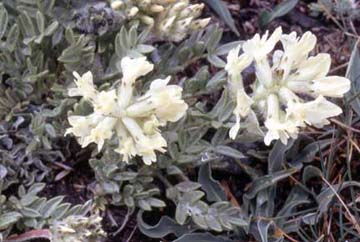 |
Northern yellow crazyweed, Oxytropis
campestris (L.) DC. var. cusickii (Greenm.)
Barneby (left). The northern yellow crazyweed is a variable,
far flung species. Twelve varieties are recognized; var. cusickii
is the only one found in Idaho. The plant grows as high as the alpine zone,
where this plant was photographed. It is a ground-hugging plant at this altitude,
with odd-pinnate leaves, each with seventeen, or fewer, leaflets and pale-yellow
to off-white flowers. Black tipped calyceal teeth seem to be typical
Bessey’s crazyweed, Oxytropis besseyi
(Rydb.) Blank. var. salmonensis Barneby
(right). Bessey’s crazyweed is characterized by
gray-green, furry leaves, and longish stems topped with tight clusters of
brightly colored red, or reddish-purple flowers. All parts of the plant save
the flower petals, are noticeably hairy. Half a dozen varieties of Bessey’s
crazyweed are recognized differentiated by differences in size, distribution,
type of hairs, etc. The species is relatively common, although the variety
shown here is not, for it is found only in Idaho where it grows in dry mountain
valleys that drain into the Salmon River south of Challis. The plant favors
rocky ground, blooming at the same time as the desert phlox (Phlox
austromontana Coville) shown in the photograph. |
 |
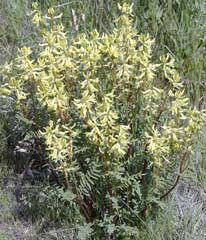 |
Late yellow crazyweed, Oxytropis
monticola A. Gray (left) is a subalpine and
alpine plant (also mountain crazyweed, formerly Oxytropis campestris
var. gracilis). The crazyweeds (or locoweeds) are so named from their
effect on grazing animals. Oxytropis means “sharp-keel”
for a pointed leading edge where two lower petals fuse. This plant's
short-stemmed, papilionaceous flowers are borne on erect stems. The leaves
are made up of varying numbers of leaflets with a single terminal leaflet
(“odd-pinnate”). The name, monticola, means
“mountain-loving.”
Nevada pea, Lathyrus
lanszwertii
(right). Lathyrus was a name used by ancient
Greeks for the European chickpea. Plants in this genus are known as
“vetchlings,” or “sweet peas” from the related European
sweet pea, Lathyrus odoratus L. They are rambling, climbing plants
whose of the (some species lack tend feather-like compound leaves
typically have the one or more tendrils at their ends). The Nevada
pea grows in high foothills to montane ponderosa pine forests. It is
distinguished by its large, white, or pink-tinged flowers borne in small
clusters. The species honors Belgian-born California pharmacist, Louis Lanszweert
(1825-1888). |
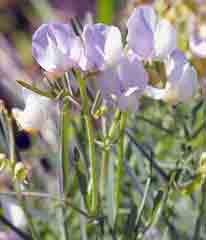 |
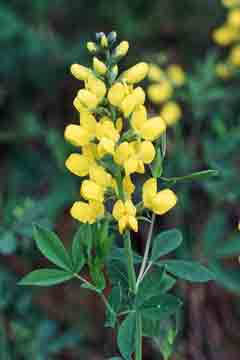 |
Mountain thermopsis, Thermopsis
rhombifolia Nutt. (left).
The mountain thermopsis (or mountain golden pea) is a tall, showy plant that
would be at home in an ornamental garden as it does well when grown
from seeds). Bright yellow, loosely clustered flowers and clover-like leaves
help to identify it. The name Thermopsis comes from two Greek words:
the first was used for lupines, and -opsis is an an ending that means
“looks like.”
Purple-flowered woolly vetch, Vicia
villosa Roth (right). This purple
flowered plant, also known as winter vetch, is a colorful native that is
often seen growing near roadsides at higher elevations. It is villous (hairy)
and its flowers grow in a spike-like cluster, always on one side of a tallish
stem—an identifying feature. Another vetch, Vicia sativa L.,
the European common vetch, or tare (not shown) is often seen near cultivated
fields at all elevations. It is characterized by large pink flowers, and
dainty vine-like foliage whose pinnate leaves end in tendrils that clasp
any nearby vegetation, commonly sagebrush in our area.
|
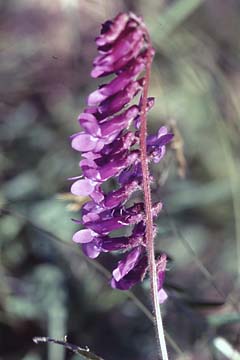 |
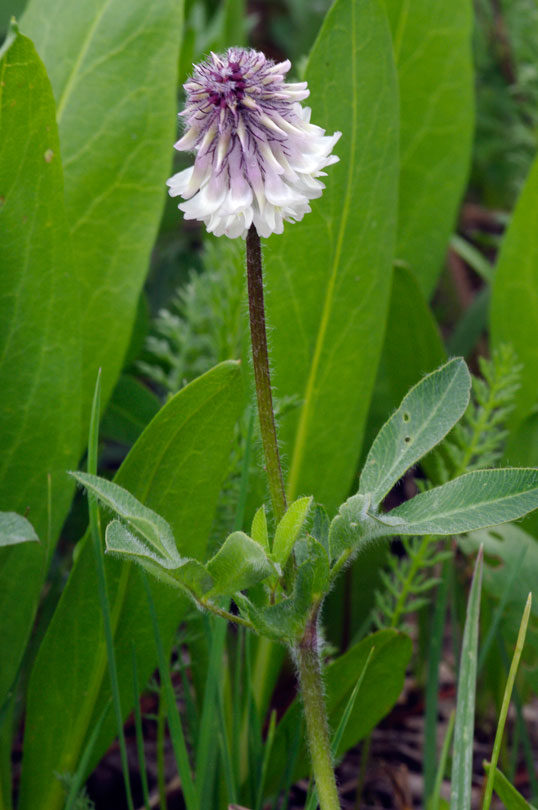 |
Long-stalked clover, Trifolium longipes
Nutt. (left). Several native clovers grow in our
mountains. This is the species most frequently seen, growing as high as the
alpine zone. It is identified by a single small flowerhead atop a rather
tall stem (longipes, means “long-stalked”). Close to a dozen
varieties are recognized; their classification is based on minor technical
differences. This plant’s flowers are white and dependent (the purple
ones in the image are unopened flowers), whereas in other varieties they
may be purple. Its trifoliate leaves bear lance-shaped leaflets.
Owyhee clover, Trifolium owyheense
Gilkey (right) is a small, nativeclover that grows on
dry ground in the Owyhee highlands in southern Idaho and adjacent oregon.
It is characterized by its rather thick gray-green leaves and attractive
flower-head. (Thanks to Mike Mancuso for showing us this rare
plant.)
|
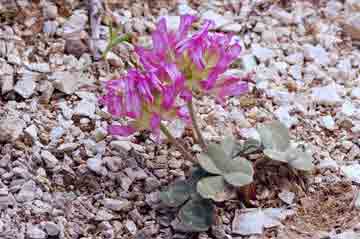 |
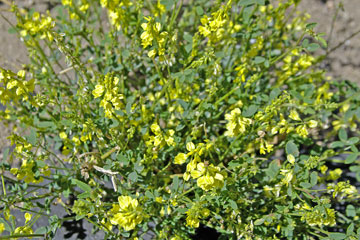 |
Yellow sweet-clover, Melilotus
officinalis (L.) Pall.
(left). Yellow sweet-clover and the very similar white
sweet clover, Melilotus alba Medik. (not shown), were both introduced
from Europe as fodder plants. Although now considered weeds, they do have
value, for they fix soil nitrogen. Their clover-like flowers and leaves are
small. Sweet-clovers are extremely common and often form large yellow patches
along our roadsides, to mid-elevations. Homer used the word melilotus
to describe animal fodder. Like many other Eurasian imports in this ,and
other plant families, sweet clovers are found everywhere in North
America.
Sainfoin, Onobrychis viciifolia
Scop. (right). Sainfoin is a European import whose
usefulness as fodder has been known for millennia. Its name
Onobrychis, from the Greek, means “donkey-food.”
“Sainfoin,” in turn, is derived from the French words
sain[t] and foin, the latter word meaning “hay,”
thus “blessed hay.” Its flowers are borne in a cluster on
a tall stem; its feathery leaves (viciifolia means “vetch-like
leaves”) have narrow, opposing leaflets. The flowers are small, but
showy, with petals that are more prominently veined than those of any other
member of the pea family in our area. The plants are common near settled
areas as high as the montane zone. |
 |
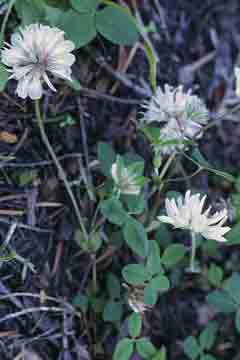 |
White clover, Trifolium repens
L. (left). The white clover is another everywhere plant,
introduced in the long-ago past; it grows in every state and province in
North America. Its species name, “repens,” is used fairly
often as a species name for creeping plants (cf. “reptile”) describing
a plant that grows along the ground. The trifoliate leaves are small and
often form patches of considerable size in moist places. It is seen, not
uncommonly, growing in high mountain meadows.
Red clover, Trifolium
pratense L.
(right). The red clover, is useful both as a cultivated
forage plant and as an ornamental. A Eurasian import, it is now well established
throughout North America s. The red clover is easily identified by its large
trifoliate leaves, ovoid leaflets, and a large and showy reddish-purple
flower head. The species name, pratense, means “of the
meadows.” It is at home in our mountains, often seen growing well away
from cultivated places, as high as the subalpine zone. |
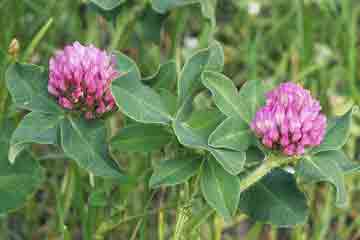 |
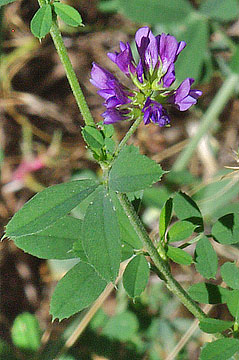 |
Alfalfa, Medicago sativa
L. (left, right) Alfalfa, as well as the four plants
shown above, the common vetch (Vicia sativa, not shown) and
several other clovers and grasses are Old World plants that have long been
cultivated as domestic animal browse. Presumably these members of the pea
famly were introduced into the New World during the imporation of cattle
from Europe. They escaped cultivation and are frequently found growing wild
near settled areas. Other species of alfalfa are sometimes
encountered: none are originally native to the United States. Medicago
sativa is the most common, frequently seen near pasteurland and along
roadsides growing to fairly high altitudes.
|
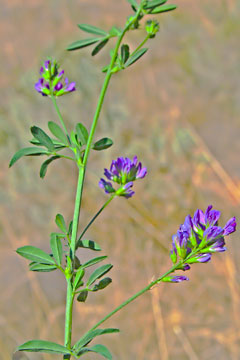 |













